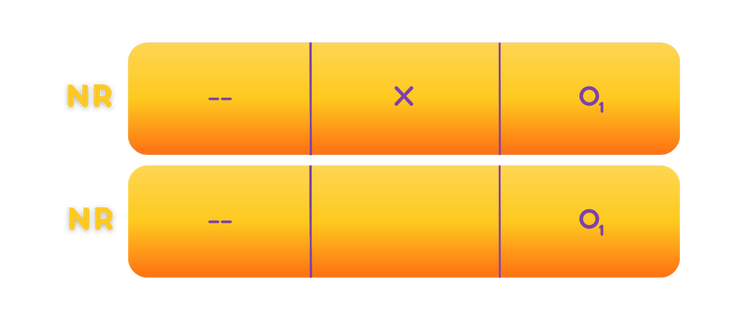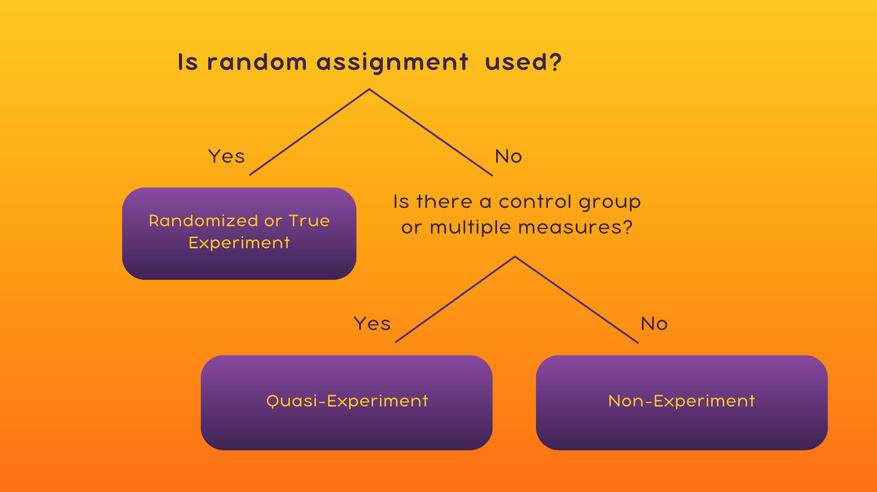Types of Pre-Experimental Research Design:
1. One-shot Case Study
- works on just one (1) experimental group and takes one (1) measure into account;
- post-test is conducted alone.
Basically, the one-shot case study compares the post-test results to the expected results.
And why?
It makes clear what the result is and how the case would have looked if the treatment was not done.

2. One-group pretest-posttest design
- works on just one (1) experimental group but takes (2) two measures into account;
- a pre-test and a post-test are conducted.
Take note that although it sounds like true-experiment, it does not have a control group.
And why?
The pre-test will tell how the group was before they were put under treatment. Whereas post-test determines the changes in the group after the treatment.

3. Static-group comparison
- works on two (2) experimental groups but takes (1) one measure of each into account;
- by 2 experimental groups it means one is exposed to the treatment while the other one is not.
Although it may look like a true-experiment, the selection or assignment are not random.
And why?
The difference of the two groups is the result of the treatment.

Types of True-Experimental Research Design:
1. Post-test-only control group design
- the control as well as the experimental group that has been formed using random allocation, are not tested before applying the experimental methodology.
And why?
This is so as to avoid affecting the quality of the study. Because the Pre-test conveys to them the basis on which they are being judged which can allow them to modify their end responses, compromising the quality of the entire research process.
2. Pre-test post-test control group design
- the control as well as the experimental group that has been formed using random allocation, are tested before applying the experimental methodology.
And why?
This two-way testing method can help in noticing significant changes brought in the research groups as a result of the experimental intervention.
3. Solomon four group control design
- this type of true experimental design involves the random distribution of sample members into 4 groups.
2 control groups that are not subjected to the experiments and changes, and
2 experimental groups that the experimental methodology applies to.
Types of Quasi-Experimental Research Design:
1. Non-equivalent groups design
- the researcher chooses existing groups that appear similar, but where only one of the groups experiences the treatment.
- when using this kind of design, researchers try to account for any confounding variables by controlling for them in their analysis or by choosing groups that are as similar as possible.
- the most common type of quasi-experimental design.
You hypothesize that a new after-school program will lead to higher grades. You choose two similar groups of children who attend different schools, one of which implements the new program while the other does not.
By comparing the children who attend the program with those who do not, you can find out whether it has an impact on grades.
2. Regression discontinuity
- many potential treatments that researchers wish to study are designed around an essentially arbitrary cutoff.
- those above the threshold receive the treatment and those below it do not.
- researchers can use individuals just below the threshold as a control group and those just above as a treatment group.
Some high schools in the United States are set aside for high-achieving students, who must exceed a certain score on a test to be allowed to attend. Those who pass this test most likely differ systematically from those who do not.
However, since the exact cutoff score is arbitrary, the students near the threshold—those who just barely pass the exam and those who fail by a very small margin—tend to be very similar, with the small differences in their scores mostly due to random chance. You can therefore conclude that any outcome differences must come from the school they attended.
To test the impact of attending a selective school, you can study the long-term outcomes of these two groups of students (those who barely passed and those who barely failed).
3. Natural experiments
- an external event or situation (“nature”) results in the random or random-like assignment of subjects to the treatment group.
- are not considered to be true experiments because they are observational in nature.
- although the researchers have no control over the independent variable, they can exploit this event after the fact to study the effect of the treatment.
The Oregon Health Study is one of the most famous natural experiments. In 2008, the state of Oregon decided to expand enrollment in Medicaid, America’s low-income public health insurance program, to more low-income adults.
However, as they could not afford to cover everyone who they deemed eligible for the program, they instead allocated spots in the program based on a random lottery.
Researchers were able to study the impact of the program by using the enrolled individuals as a randomly assigned treatment group, and the others who were eligible but did not succeed in the lottery as a control group.
Non-Experimental Research Design
- Does not involve the manipulation of variables
- Researchers have no control over the variables
- Can be more quantitative and qualitative
- Independent variables are generally not involved, but if they are, they cannot be manipulated
- These experiments are carried out in natural setting, hence not tampering is done
- They may not provide any information about the causal factors in the study
- As it is more descriptive, it answers the "WHAT's" of the study
- Used to define a subject, compare situations and measure data trends
- Conducted in natural settings
Benefits of Non-Experimental Research:- Non-experimental research designs does not require the same financial resources or time as experimental research.
- This is also easier to regulate and less challenging than an experiment because it is not necessary to construct a controlled environment.Disadvantages of Non-Experimental Research:- Because hypothesis testing is not as reliable as experimental research, examining a large number of variables at once can be difficult.
- The number of naturally occurring variables in the environment can limit the capacity to test hypotheses, making finding the proper data challenging.
- Researchers collect data without treatments or making any changes.
- No random assignment.
- No control group nor multiple measures.
- The research question is focused more on what it is like to have a particular experience.
- Just about exploring one variable and not anything about the relationship between two variables.

Descriptive Research Design
- Its main purpose is to observe, describe, and document aspects of a situation as it naturally occurs and sometimes to serve as a starting point for a hypothesis generation or theory development.
Types of Descriptive Research Design:
1. Survey
- when the researcher intends to provide a quantitative or numeric description of trends, attitudes, or opinions of a population by studying a sample of that population.Example: Universities regularly float surveys to determine customer satisfaction.
2. Correlation
- calculate the correlation coefficient.
a) Bivariate Correlational Studies - obtain scores from two variables for each subject, then use them to calculate a correlation coefficient.
Example: Children of Wealthier (Variable #1) and better educated (variable #2) earn higher salaries.
b) Prediction Studies - use the correlation coefficient to show how one variable (the predictor variable) predicts another (the criterion variable).
Example: Which high school applicant should be admitted to college?
c) Multiple Regression Prediction Studies - suppose the high school GPA is not the sole predictor of college GPA, what might be other good predictors? All of these variables can contribute to the over-all prediction in an equation that adds together the productive power of each identified variable.
3. Ex-Post Facto
- non-experimental designs used to investigate the causal relationship.Example: Effect of homeschooling on the social skills of adolescents?
4. Comparative
- comparative design involves comparing and contrasting two or more samples of study subjects on one or more variables, often at a single point in time.Example: Comparative study on the health problems among rural and urban older people from district Mehsana, Gujarat.
Specifically, this design is used to compare two distinct groups on the basis of selected attributes such as:a. Knowledge level
b. Perceptions
c. Attitudes
d. Physical or psychological symptoms
5. Evaluative design
- conducted to elicit useful feedback from a variety of respondents from various fields to aid in decision-making or policy formulation.
Used to determine the:
a. Quality of implementation of a project
b. Efficiency and effectiveness of a program
c. Assessment of organizational processes like procedures, policies, guidelines, human resource development, and the likeExample: A test of children in school is used to assess the effectiveness of teaching or the deployment of a curriculum.
6. Methodological
- in this approach, the implementation of a variety of methodologies forms a critical part of achieving the goal of developing a scale-matched approach where data from different disciplines can be integrated.Example: N/A